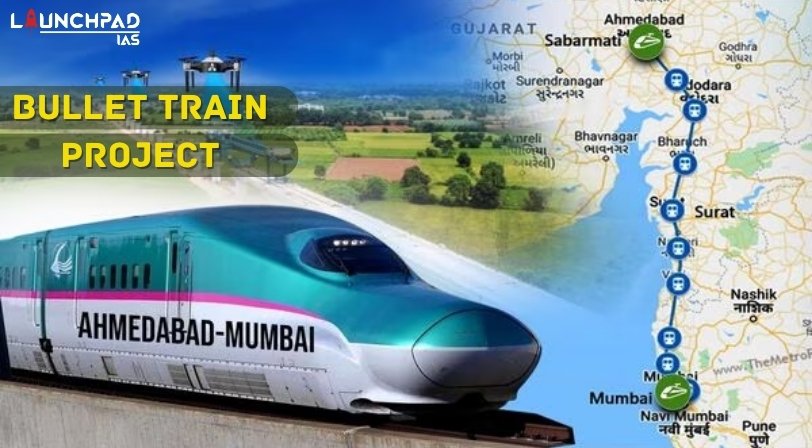What are Bullet Trains?
- The Shinkansen high-speed trains of Japan are colloquially called bullet trains for their appearance and speed.
- It is a term generally used to describe a high-speed train of speeds above 250 kmph.
The First Indian Bullet Train Project

- India’s first bullet train will run in the Mumbai and Ahmedabad high-speed rail corridor, whose construction began in September 2017.
- It is a 508 km long high-speed rail corridor built with the help of Japan.
- The train will run at a speed of 320kmph and is expected to be completed by 2022.
- The 2009–2010 Rail Budget of India introduced the Mumbai–Ahmedabad corridor and 5 other high-speed rail corridors for a feasibility study
Finance and Technology
- India currently does not have indigenous high-speed rail technology.
- The technology is provided by Japan and also 81% of the project cost is financed by Japan at an interest of 0.01% for 50 years.
Comparison of Costs
- According to an analysis done by the World Bank regarding the costs of High-Speed Rail (HSR) projects in different countries, rail infrastructure accounts for 82% of the total cost.
- The cost of the Mumbai-Ahmedabad HSR project is nearly $27.44 million per km compared to the $17-21 million per km of China.
- China is not dependent on the Shinkansen technology and although a late entrant, the HSR projects of China are cheaper than those of Japan.
- In 2015, China won a project in Indonesia against Japan for its cost competitiveness.
- The loan and interest rate by Japan which seems quite tempting at first look is not so. The Japanese Yen is projected to appreciate against the Indian Rupee over the period questioning the viability of the loan and the project on the whole.
What are the Pros of the project?
Convenience
- Having an alternative mode of transport will decongest the roads.
- Also, the speed of bullet trains will save time and boost businesses in large cities where time is money.
- The interconnectedness between the towns and cities would reduce the hassle of commuting thereby helping in reducing the migration.
Safety
- Safety has been one of the major concerns of Indian Railways.
- The record of bullet trains in the field of safety has been impeccable.
- The Shinkansen trains of Japan started in 1964 report no fatalities till date.
Environment-friendly
- In today’s global environmental scenario, any step that checks the pollution is welcome.
- The emissions of CO2 per passenger km from speed rails are way less compared to those of automobiles and airplanes. It emits an eighth and a fifth of emissions respectively.
Economic growth
Bullet Train Project will help in the infrastructure development thereby spurring the economic growth and creating huge employment opportunities.
What are the Cons of the project?
Costs
- The Mumbai- Ahmedabad high-speed rail costs around one lakh crore Indian Rupee.
- Considering the cost overruns due to delays and future fluctuations of inflation, it may further increase.
High fares
- It is estimated that the fares may range in between Rs. 4000 to Rs 5000 to make the running of trains economically viable.
- Such fares would be affordable only to the rich who might prefer air travel considering the lesser margin of fares between them.
- However, most of the travel by train in India is done by the poorer sections.
Land acquisition
It might act as another obstacle delaying the Bullet Train Project and also causing large-scale displacement of people.
What are the Arguments against Bullet Trains in India?
- The Indian Railways is worrying. There is a need to strengthen the present infrastructure of the railways.
- The recent number of increasing rail accidents and the Elphinstone road station stampede further strengthens this case.
- The recent report by the Standing Committee on Railways headed by Sudip Bandopadhyay said that in 2014-15, about 40% of the accidents occurred at Unmanned Level Crossings, and in 2015-16, about 28%.
- The committee also recommended a complete shift to LHB coaches to minimize the loss of lives in case of derailments.
Thus, the argument is, instead of strengthening and upgrading the current infrastructure keeping in mind the safety of millions of passengers, why invest in a project catered to the well-off sections?


